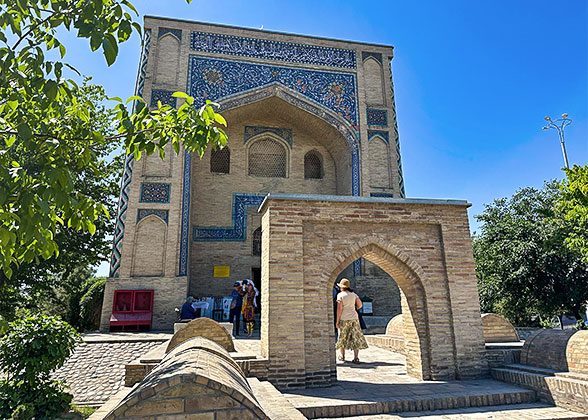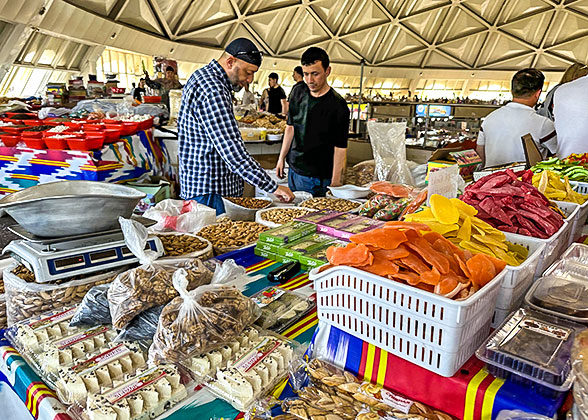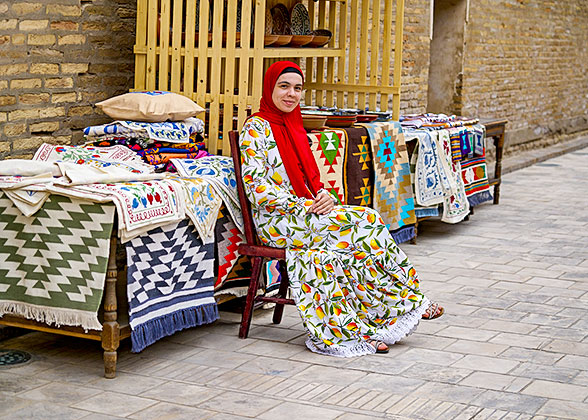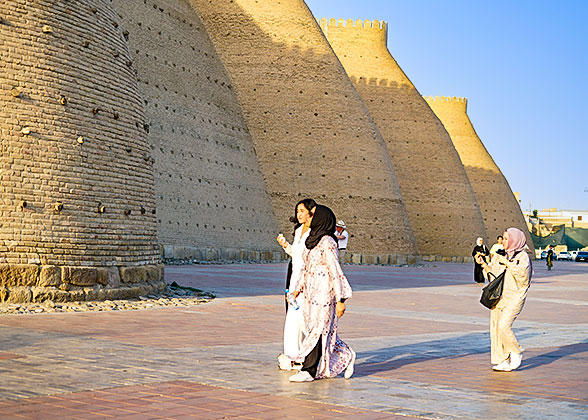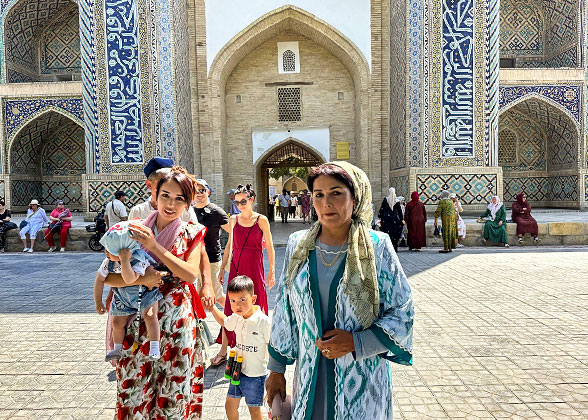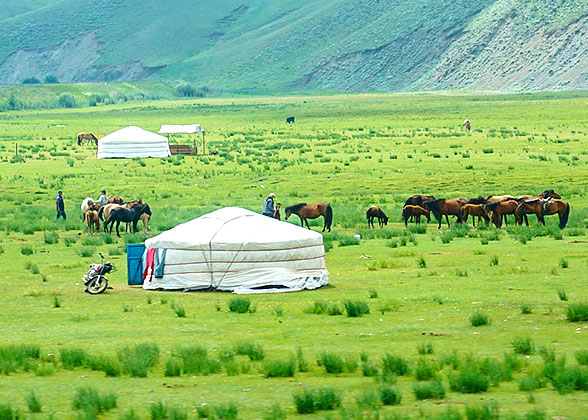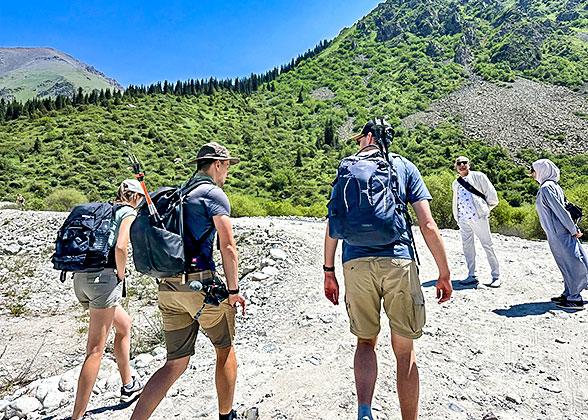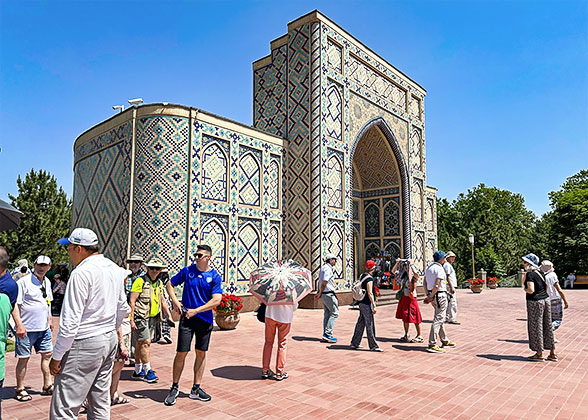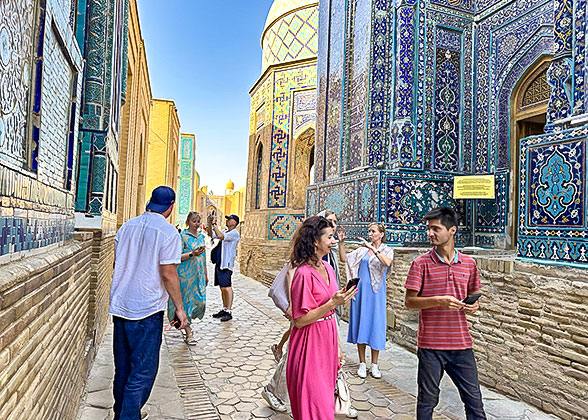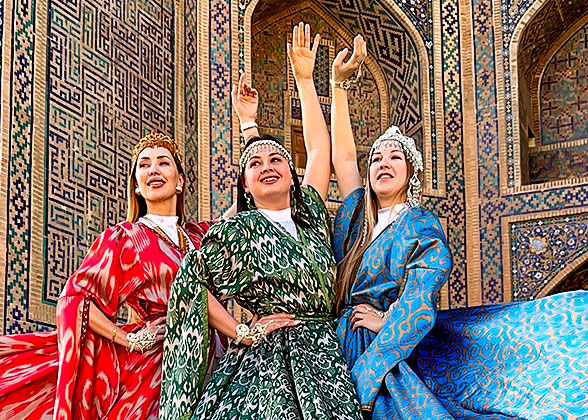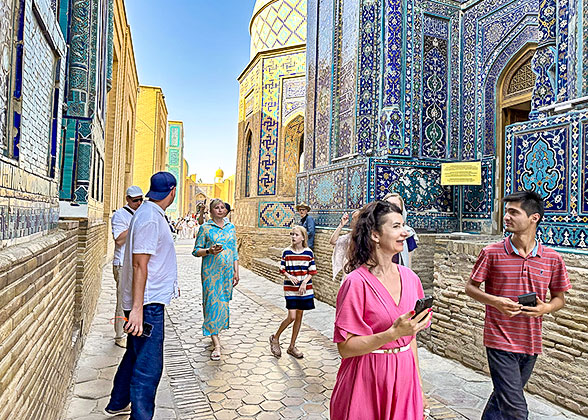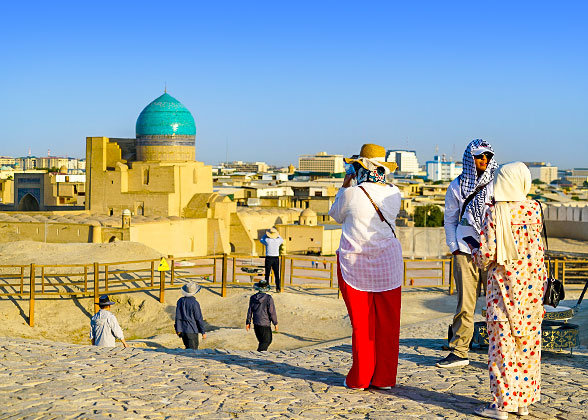Day 1: Airport Pick-up; Tashkent Visit: Khast-Imam Complex, Chorsu Bazaar, Museum of Applied Art
Welcome to choose this 10 days Uzbekistan itinerary! Upon arrival in the capital city, Tashkent, the driver will pick you up at the airport and transfer you to the hotel for check-in. Tashkent literally means ‘the City of Stones’, whose history can be traced back to the 2nd century; by the 6th century, it had evolved into a vital hub on the Silk Road. Nowadays, it remains Central Asia’s largest metropolis and a pivotal economic and cultural center. Our Tashkent city tour will start from the Khast-Imam Complex. On the square, you’ll first notice the symmetrical Abubakr Kaffal-Shashi Mausoleum, the resting place of a revered 10th-century polymath known for his expertise in Quranic studies, poetry, and craftsmanship. Tilla Sheikh Mosque is another important building, which is said to preserve the hair of Muhammad. Standing outside the mosque, you can see its twin 54-meter-high (177-foot) minarets. Stepping in, its gold-embellished azure dome decorated with intricate patterns will captivate your eyes. Adjacent to its west, the Madrasah of Barak-Khan now houses souvenir shops, and the Islamic Institute of Imam al-Bukhari at the north corner of the square continuously serves as a prestigious Islamic academic institution. Then, head to Tashkent’s largest market, Chorsu Bazaar, whose huge dome can be seen from many places in the city. Stepping in, you’ll find that the butchers are arranged in a concentric circle on the ground floor, and upstairs, spice stalls mingle with fruit and vegetable booths. Wandering in its open-air areas, try fresh pomegranate juice, kebabs, and Uzbekistan bread on your own. Leaving the bazaar, we will then head to the State Museum of Applied Art, where handicrafts such as wooden carvings, Suzani embroideries, and crockeries from all over Uzbekistan are displayed. In addition to the delicate exhibits, the green-and-blue miniature-decorated facade of the museum will dazzle your eyes, which looks like patches of Persian Speedwell from afar. Afterwards, descend to the underground to admire the uniquely decorated Tashkent subway stations and take a subway to Independence Square. Then, take a leisurely walk to the Amir Timur Square and complete today’s itinerary at the Earthquake Memorial.  Things to be Prepared: 1. Visa Requirement: The visa-free policy is implemented for passport holders from the EU and other 66 countries, including the UK, Canada, and New Zealand. Americans under 16 and over 55 can enter Uzbekistan without a visa as well, while other US citizens need to apply for an e-visa 1-2 weeks ahead of time. 2. Things to Pack: Since Uzbekistan is a Muslim country, to show respect, ladies need to avoid wearing skirts or hot pants, while men should avoid tank tops. The temperature soars to 40°C (104°F) in summer (July-August), so sun-protective gear is important. Apart from that, most cities in Uzbekistan are surrounded by desert, and the air may be dusty; hence, masks are essential. Accommodation: Wyndham Tashkent (4 stars) or similar
|
Day 2: Fly to Urgench, Drive to Khiva: Kalta Minor Minaret, Tosh-Hovli Palace, Kunya-Ark
A Journey to Khiva Old City In the morning, you’ll be escorted to the airport for a flight to Urgench. Upon landing, the driver there will pick you up and transfer you to the hotel in Khiva. Initially built in the 5th century BC, Khiva flourished as a vital crossroads of commerce and cultural exchange on the ancient Silk Road. Today, its architecture continues to whisper of the meeting of civilizations. Your local guide will accompany you to wander in Ichan Kala, the inner city of Khiva, which preserves more than 50 historical sites and 250 old houses to look for traces of Persia, Turkic, and China. First, we will head to Muhammad Aminkhan Madrasah and Muhammad Rahim Khan Madrasah, two Islamic institutions, and admire the adjacent Kalta Minor Minaret. Initiated in 1855, its construction was suspended after the death of Amin Khan, leaving this 29-meter-high (95-foot) tower uncompleted, despite its original planned height of 110 meters (360 feet). Nevertheless, its blue surface stands out among various amber-hued buildings. Then, take a look at the exquisite carved wooden pillars at Juma Mosque and drop by the Tosh-Hovli Palace, the residence of rulers, to see Khiva’s most dedicated inner-house decorations, such as walls full of miniatures and columns carved with hollow patterns. If lucky, you may also encounter local artists performing traditional Uzbek songs and dances. After glimpsing the Pakhlavan Makhmud Mausoleum, we will stop at the foot of the Islam Khodja Minaret. Soaring 56.6 meters (185.7 feet), it is the tallest structure in Khiva. If interested, you can climb up its 175 steps to the top to gain a panoramic view over the entire inner city. Finally, let’s enter the Kunya-Ark. This 12th-century fortress not only served as a royal residence for Khans and their families but also as a strategic military stronghold in ancient times. Within its museum, you can discover the scale model of the complex, preserved frescoes, and the recreated scene of the mint. Up to its watchtower, you can admire the serpentine city walls and Khiva's iconic skyline punctuated by turquoise domes. Finally, the guide will escort you back to the hotel.  Night Activity Suggestion (at your own expense): After sunset, Khiva will be illuminated by lights. Wandering through its alleys, you’ll have a feeling of being in the story of The Thousand and One Nights and may catch a beautiful music and dance show at the street corner. For tranquil night views, you can dine at the Terrassa Cafe & Restaurant. From its terrace, you can overlook the glowing Kunya-Ark walls and Kalta Minor Minaret. Savor Shivit Oshi, a kind of green noodles dyed with dill juice. The boiled noodles always have stewed beef, potatoes, and carrots as toppings, paired with yogurt or sour cream. Remember to reserve a seat ahead of time. Average Cost per Person of the Restaurant: UZS 270,000 (USD 20) Address of the Restaurant: Terrassa Cafe Khiva, Khiva 220900 Uzbekistan Meals: Breakfast Accommodation: Hotel Asia Khiva (3 stars) or similar Ichan Kala of Khiva Local People in Khiva
|
Day 3: Drive 7 Hours from Khiva to Bukhara through the Kyzylkum Desert
Today, the driver will take you through the vast Kyzylkum Desert to Bukhara, taking 7-8 hours en route. Meaning "Red Sand" in Turkic languages, Kyzylkum lives up to its name with rust-red sands. Beyond sweeping dunes, you can see eroded highlands and crumbling city walls. Spanning hundreds of kilometers, this wilderness is scattered with hardy, low-growing desert flora and inhabited by some desert animals like wild camels. The road in the desert is unpaved, so it may be quite bumpy. It is recommended to prepare a neck pillow and Dramamine if you have car sickness.  Enigmatic Story of Kyzylkum Desert Centuries ago, the Amu Darya River nourished this desert and nurtured the ancient Khwarezmian Kingdom. By the 7th century BC, the kingdom thrived as a crucial hub on the Silk Road, whose remnants were said to be buried beneath the sands. In an archaeological excavation, a remarkable collection of ancient petroglyphs astonished the world. These enigmatic carvings depicted figures in suits akin to modern spacesuits and objects resembling spacecraft. These perplexing discoveries challenge conventional understandings of ancient civilizations, fueling speculation that they might represent evidence of early encounters with extraterrestrial visitors. The truth, however, remains veiled in the desert's dust. As soon as we arrive in Bukhara, you’ll be transferred to the hotel to have a good rest and replenish from the long road ride. With over 2,500 years of history, Bukhara served as the capital of the Samanid Empire (875-999), was once conquered by Genghis Khan, and later became a part of Timur’s realm. Unlike more exquisite Khiva, Bukhara pulses with authentic everyday life, blending with historic elements. We'll spend two full days in this captivating city, during which you can not only wander through stunning historical monuments but also slow down to experience the local life as a "true Bukharan." Meals: Breakfast Accommodation: Volida Hotel Bukhara (3 stars) or similar
|
Day 4: Bukhara: Magoki-Attori Mosque, Chor-Minor Madrasah, Ark Fortress
Today, have a walking tour in Old Bukhara with your local guide, which will start at the heart of Bukhara, Lyabi Hauz Ensemble. Dominated by two ancient Islamic scholarly legacies and a Sufi sanctuary and scattered modern restaurants, souvenir stores, and cafes, it is an ideal place to experience the blend of traditional and contemporary life of Uzbekistan. Then, wander across the square to the Magoki-Attori Mosque. Initially, where the mosque now stands was a Zoroastrian fire altar, later overlaid by the buildings of Buddhists and Jews. The structure you can see nowadays was built in the 8th century. On its weathered portal, you can still see the distinct carvings and blue-tile patterns. Later, we will head to Chor-Minor Madrasah, the well-known iconic structure in Bukhara, which is actually the gatehouse of a ruined 19th-century madrasa. On the four surviving towers, you can see different geometric mosaics patched with azure and emerald tiles. According to folklore, each tower represents a dynasty or a religion. Wandering around the madrasah, you’ll find a small bazaar selling Soviet-era relics and traditional Uzbek crafts. Afterward, take your time to explore the stalls in the Trade Domes Market to admire vibrant ceramics, handmade carpets, miniatures, and embroideries. Passing through ancient Islamic academies, the Ulugh Beg Madrassah and Abdulaziz Khan Madrassah, we’ll stop at the 45.6-meter (150-foot) high Kalyan Minaret, the tallest building in the old city. Standing at its base and looking up, you’ll be wowed by its dedicated brick adornments and stalactite-like eaves. Adjacent to the minaret are the Kalyan Mosque, the largest mosque in Bukhara, and the Miri-Arab Madrasah, one of the most sacred and oldest Islamic schools built in the 16th century. Next, it’s time for today’s highlight - Ark Fortress. As Bukhara’s oldest building, it dates back to the 5th century BC. Enduring the invasion of the Mongols, Arabs, and Tsarist Russia, it was left in ruins, and only parts of it have been revived. In its museum, many relics, including the Quran and the Emir’s royal clothes, are showcased. If interested, you can climb up to the watchtower to capture a panoramic view of the fortress and Bukhara. After that, visit the Bolo Khauz Mosque, famous for its wooden columns with intricate carvings. Today’s sightseeing will end at the Samanid Mausoleum and Chashma Ayub Mausoleum.  Recommended Restaurant (at your own expense): The Marvrigi Restaurant is housed in a renovated madrasa, whose courtyard is draped with colorful Suzani textiles. Occasionally, there is a live music show. You can try plov, a traditional Uzbek rice dish with stewed carrots, chickpeas, and mutton or beef as toppings, and sometimes raisins are added for their sweetness. To conclude the meal, you can order a cup of cinnamon-spiced tea to cleanse your palate. Average Cost per Person: USD 5. Credit cards are acceptable. Address: B. Nakshband, Bukhara 200124 Uzbekistan Meals: Breakfast Accommodation: Volida Hotel Bukhara (3 stars) or similar
|
Day 5: Bukhara: Visit Summer Palace & Chor-Bakr Necropolis, Relax at Local Teahouse
Today, your guide and the driver will be waiting for you at the hotel, from where we will drive to the suburbs to the Summer Palace (Sitorai Mohi Hosa), blending European and Central Asian architectural styles. You can see Russian onion domes, Uzbek horseshoe arches, and 6-point stars in one building. Then, drop by the Memorial Complex of Bahouddin Naqshband, where the saint Naqshband rests, and stop at Bukhara’s largest burial complex, Chor-Bakr Necropolis, also named “the City of the Dead”, whose earliest graves can date back over a millennium. As an off-the-beaten-path spot, it offers a quiet exploration. Here you can see the distinctive tomb structure, Khazira. The tomb is set in a courtyard surrounded by huge walls with an entrance, and each courtyard contains the remains of the deceased from the same dynasty. Beyond architecture, you can also see peacocks roaming around, and pigeons flock to the pool.
★ Relax with a Cup of Uzbekistan TeaAfter returning from the suburbs, a relaxing experience of "Silk Road Spices" teahouse is ready to entertain you. Since tea was introduced to Uzbekistan via the Silk Road, it has been beloved by locals. After centuries of evolution, spice tea has emerged, quickly seized the market, and been integrated into people’s daily lives. Our well-chosen teahouse serves tea with spices such as star anise, cardamom, cinnamon, or cloves. The Spice & Herb Tea is worth trying, which adds the mint, oregano, and bergamot to enrich the flavor and is believed to benefit digestion, kidney function, and the nervous system. Without sugar and milk, it may taste a little bitter, but you can pair it with the offered desserts, which will bring you a diametrically different experience from Western tea. Taking a sip of tea and admiring walls decorated with vibrant Uzbek Suzani embroidery carpets and yellow wooden tables and chairs, you’ll have an illusion of being in an ancient caravanserai.
At the end of the day, you’ll be escorted back to the hotel. If you have enough energy, you can take a walk by yourself to the Kalyan Minaret at night when the tower and mosque get illuminated.
Meals: Breakfast
Accommodation: Volida Hotel Bukhara (3 stars) or similar
|
Day 6: Bukhara - Gijduvan Pottery Workshop - Nurata Town - Camel Ride & Camp in Kyzylkum Desert
Today, our driver will transfer you to the Safari Yurt Camp in the Kyzylkum Desert. On the way, we will first drop by the pottery workshop in Gijduvan, where you’ll witness the ceramics-making process and admire exquisite porcelain plates or cups. Continue driving 2 hours east, and we will arrive at Nurata, a city originally built by Alexander the Great in the 4th century. As legend goes, thousands of years ago, a meteorite fell here, and a spring appeared in its meteor crater. The extraterrestrial stone brings about 15 trace elements to the water, such as gold, silver, and iodine, and is believed to have a healing function. Standing by the so-called holy spring, you may see the sacred Marinka fish. After a peek at the mosques near the spring, we will drive northward and stop at the Nurata Pass to explore petroglyphs and admire the stunning scenery. Then, another 1-hour drive will lead you to the Safari Yurt Camp. Upon arrival, you can rest in the yurt for a while. Framed by slats and covered with felt, the traditional Uzbek yurt can stay cool in summer and cozy in winter. Inside, you can see hand-embroidered tapestries adorned with intricate botanical motifs and geometric patterns hanging on the wall. ★ Enjoy Camel Trek & Folk Music in Desert CampAfter a brief respite, an exciting sunset camel ride will be waiting for you. Ride through the groves of saxaul trees and ascend the dunes nearby. Before the sun dips under the horizon, you’ll see the desert in a hue of amber and crimson. When night comes, a bonfire folk music show will be arranged. Sway with the rhythm of the song and enjoy a chill night under the starry sky.  Kindly Reminder: 1. Although meals are included, it is recommended that you bring some drinking water and snacks, as there are no shops along the way and at the camp. 2. The road condition is poor in the desert, and it may be quite jolting. A headrest and Dramamine are useful to alleviate car sickness. Meals: Breakfast, Lunch, Dinner Accommodation: Kyzyl Kum Safari Yurt Camp Safari Yurt Camp Nurata Pass
|
Day 7: Kyzylkum Desert - Aidarkul Lake - Samarkand
After checking out the yurt in the morning, the driver will escort you to the adjacent Aidarkul Lake, where you’ll see a surreal landscape: shimmering turquoise waters meet golden dunes, as well as mountains in the distance. This oasis provides an ideal habitat for desert wildlife. Walking along the shore, you may find footprints of wolves, foxes, or waterfowl. If you visit here on cold days, you might discover the white salt crystals along the waterline. Leaving the lake, we will drive 4-5 hours to Samarkand and transfer you to the hotel as soon as we arrive. With a history spanning 2,600 years, Samarkand was once home to the legendary Sogdians, a commercial ethnic group in Central Asia that extended their trade network from China to Persia and even Europe along the Silk Road that flourished in the 7th century. And Samarkand thus had become one of their main trade hubs. However, the Sogdian era came to an abrupt end with the arrival of Genghis Khan in the 13th century. When it came to Timur’s enthronement in the 14th century, Samarkand was rebuilt, but the traces of Sogdian culture were overlaid with Islamic architecture, fusing with Persian, Turkic, and Arab styles.  Recommended Restaurant in Samarkand (at your own expense): After settling down, you can make your own way to the Alibek Somsa Restaurant, a beloved local restaurant specializing in somsa, a kind of Uzbekistan’s traditional savory stuffed pastries. From its open kitchen, you can watch how the chef shapes the dough and attaches somsa to the wall of the tandoor clay oven. The cooked ones are golden and crisp, best enjoyed with tangy chili-laced sauce. Beef and mutton somsas are hot-selling, and vegetable-filled ones are also served. Price per Somsa: UZS 10,000 (USD 0.7) Address: JXG4+5PJ, Mironshokh Mirzo Str, Samarkand, Samarqand Region Meals: Breakfast, Lunch Accommodation: Grand Samarkand Superior (4 stars) or similar
|
Day 8: Samarkand: Bibi Khanym Mosque, Shah-i-Zinda Necropolis, Gur-Emir Mausoleum
After breakfast, the guide will first accompany you to visit Registan Square, the spiritual center of Samarkand. Then, wander through the Siyob Bazaar and stop at Bibi Khanym Mosque, whose huge corrugated dome is eye-catching among the surrounding buildings. Standing at the entrance, you can see its towering portal adorned with intricate girih that resemble the galaxy. In its courtyard, a minaret pierces into the sky, and a marble base lies quietly with a huge Quran on it. It is said that the mosque was built by Timur’s wife, Saray Mulk Khanum, the descendant of Genghis Khan. That is to say, the destroyer of Samarkand – Genghis, and its rebuilder – Timur were linked by marriage across centuries and both reshaped Samarkand's destiny. Afterward, we'll drive to the biggest observatory in Central Asia's history - Ulugbek Observatory, where the astronomer Ulugbek observed and recorded the position of at least 1018 stars. In the nearby museum, you can find the frescoes of this scientist, his manuscripts, and the ancient astronomical instruments he used. Then, visit the shrine of Central Asian Islam, Shah-i-Zinda Necropolis. The extant 14 tombs in the complex rise from the sides of a narrow alley, and some of them are covered with exquisite mosaic tiles. Finally, let’s explore the tomb of Timur and other royal members - the Gur-Emir Mausoleum. Stepping inside, you’ll be intrigued by the domes decorated with representative blue patterns, which look like the starry sky. Under the dome, standing tombstones, among which Timur’s dark-green coffin is the most remarkable.  Dinner Suggestion (at your own expense): Karimbek Restaurant, which mainly serves grilled meats, is recommended. There are two floors. The first floor is buzzing, and there will be folk performances occasionally, during which you’ll have a chance to be invited to join the dancing. The second floor is much quieter. You can order pelmeni - traditional Uzbek dumplings, as a starter, and Laghmon noodles and grilled meat as mains. Average Cost per Person: UZS 150,000 (USD 12) Address: Gargarina St. 194, Samarkand 140164 Uzbekistan Meals: Breakfast Accommodation: Grand Samarkand Superior (4 stars) or similar
|
Day 9: Samarkand: Afrasiab Museum, Koni Ghil Village; High-speed Train to Tashkent
Grab the last day to sightsee in Samarkand. After picking you up from the hotel, your guide will first escort you to the Afrasiab Museum. Housed at the center of the Sogdians' ancient settlement, the museum preserves relics excavated from the ruins. Among various exhibits, the 7th-century frescoes in the “Hall of Ambassadors” are a must-see, which depict the diplomatic scenes, religious rituals, and royal activities of Sogdians. In addition, you can see other remnants such as the carving of gypsum, clay altars, and ceramic funerary ossuaries. Then, visit the Tomb of Saint Daniel. It is said that the corpse of the saint is constantly growing, and now his coffin is 18 meters (59 feet) long.
★ Explore the Ancient Paper-making Process in Koni Ghil VillageAfterward, we will drive to Koni Ghil Village to learn about the traditional making process of Samarkand paper. In the 8th century, ancient Chinese paper-making technology was introduced to Central Asia through the Silk Road, and Samarkand became the hub of paper-making. Today, the Koni Ghil Village holds the only mill that practices this ancient craft, where you can witness how branches of mulberry become slices of paper and handicrafts such as postcards and clothes embroidered with patterns. Allegedly, the site was used to raise deer and served as a leisure estate for nobles to hunt, hence a quite stunning environment: streams flow across the village, and above the water surface, waterwheels swirl slowly. Enjoy some free time to wander around or drink Uzbek tea at a teahouse.
After returning to the city center, the driver will escort you aboard the high-speed train to Tashkent. In about 2 hours, the Tashkent driver will be waiting for you at the train station and send you to the hotel.
Meals: Breakfast
Accommodation: Wyndham Tashkent (4 stars) or similar
|
Day 10: Tashkent Airport See-off
Your Uzbekistan itinerary 10 days will end after the driver transfers you to the airport. Wish you a pleasant journey home! Want to discover more stories along the Silk Road? We can expand your trip to other ‘stan’ countries, such as Kyrgyzstan and Tajikistan, or further west to Turkey or Greece. Its eastern starting point, Xi’an, China, is also worth a visit. Welcome any inquiries, and we will reply within 12 hours.
Meals: Breakfast
|

